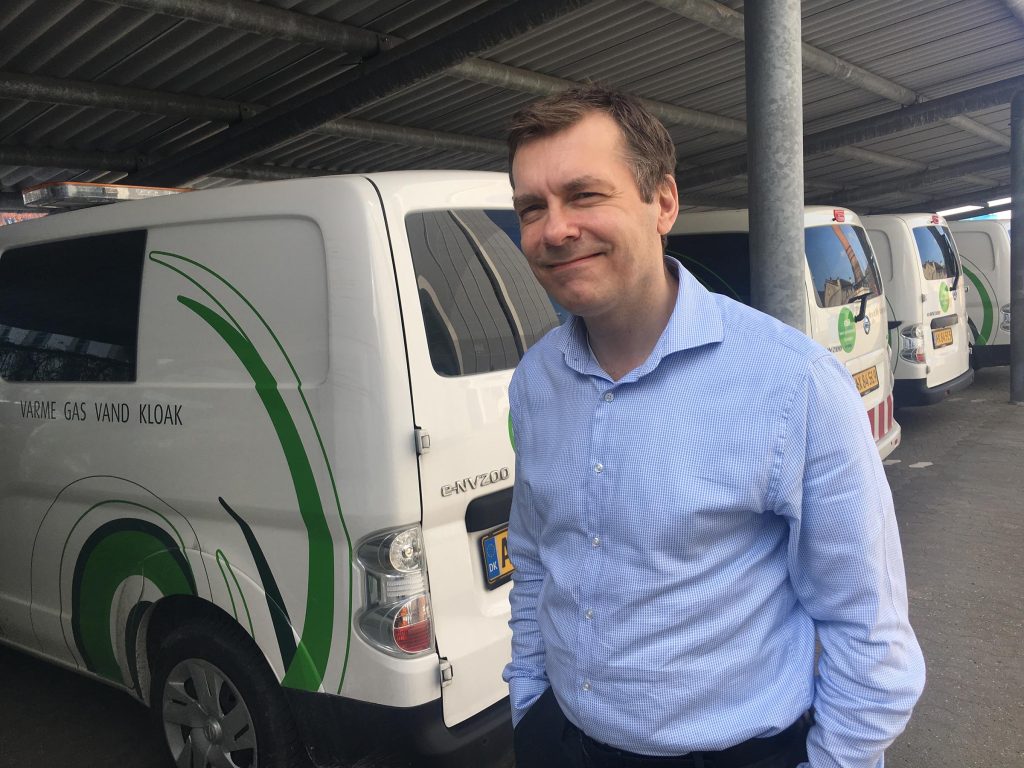Frederiksberg Forsyning (or Frederiksberg Supplies, in English) has gained a lot of international attention due to its 10 electric vehicles (EVs) using Nuvve’s vehicle-to-grid (V2G) platform as a part of a busy workday. And the utility sector plays a very important role in the green transformation, according to the Head of Strategy, Kristian Beyer.

Kristian Beyer, Head of Strategy, Frederiksberg Forsyning
“Welcome to the most photographed garage in Denmark,” jokes Kristian with a smile. He points to the 10 white electric vans parked side by side in front of Frederiksberg Forsyning. They need a wash after a long week of work to get ready for a delegation from the EU-Parliament. “The V2G project with these 10 electric vehicles is the green initiative that has by far created the most international attention for us. We have had visits from the BBC, French Television, Scandinavian Car Magazines, and delegations from the EU have been here several times.”
Frederiksberg Supplies has had the 10 electric vehicles using V2G since 2016. Initially, they were part of the Parker Project, which investigated V2G benefits in an operative car fleet. Now the company is a valued customer of Nuvve’s V2G commercial offering, available throughout the country.
We interviewed Kristian to better understand his experience with EVs, V2G, and Nuvve.
Why did you get involved with the Parker Project?
We had the ambition of making our car fleet C02-neutral and at the same time taking a critical look at our green profile. EVs were starting to gain traction here in 2016 and we tested two older EVs as part of our fleet. However, the test did not turn out as expected, and to be frank, the vehicles were not popular among our employees. So, when we got the chance to try again with 10 new EVs, it created a lot of nervousness. I remember sitting with some colleagues one afternoon where we asked ourselves, “Do we dare to do this?” It was easy to buy the 10 EVs but weren’t sure how to convince our employees that it was a good idea.
What convinced you to move forward with Nuvve?
The Parker Project and the dialogue with Nuvve gave us insight into the rapid development of the technology behind the EVs. And it was enticing for us to be a part of this development. As a supply company, we have to be first movers and be leaders in the green transformation. If we can reduce our C02 footprint, it will positively affect the 100,000 citizens living in Frederiksberg. For that reason, we have already taken on many sustainable initiatives. We have installed solar panels on the roof of our main office, we only use rainwater in the toilets, and we have windmills producing electricity for the building. We strongly believe that EVs are part of the future for all of us, so we have to show the citizens that it is possible.
What were the employee concerns?
There has been a myth among the employees that the EVs would run out of power. So Nuvve gave all the employees a guarantee that the EVs would always have enough power in the batteries. In the beginning, the cars were fully charged each morning, but now, we have set the charge level at 75 percent. The cars only drive a few kilometres during a workday so they are not even close to running out of power. Today, our employees have integrated the EVs in their daily work. So for us, the biggest challenge was taking the first step and finding the courage to reorganise our car fleet.
What future opportunities do you see with Nuvve?
While the EVs are charging, we have the possibility of using the extra power of the batteries as a part of our electric supply in this building. When we turn on the light in our office, some of the electricity comes from the cars. Also, we need a place to contain the electrical power coming from sustainable sources – for example the solar panels on the roof or the windmills. And we might be able to use the batteries in the cars for that purpose, which is extremely interesting for us. This would take us right into the future of sustainable energy sources and new ways of containing the energy!
What role do you see the attention you’re getting from V2G playing?
It gives us a boost that we, despite being a relatively small town with 100,000 citizens, can act as a flagship for green transformation and help a technology like V2G get off the ground.
###
Kristian Beyer is head of Strategy at Frederiksberg Supply (Frederiksberg Forsyning in Danish) and was involved in implementing the Parker Project, which was a research and cooperation project led by the Danish Technical University (DTU) and funded by the Danish Energy Agency (EUDP). The purpose of the Parker project was to examine the potential of using V2G in a car fleet operation on a daily level and monetize the operation by providing services to the Danish energy markets. The Parker Project was completed in July 2018 and showed revenues of 1860 Euros per vehicle per year over 2 years from the V2G operation by Nuvve. For further info, please visit Parker Project.




